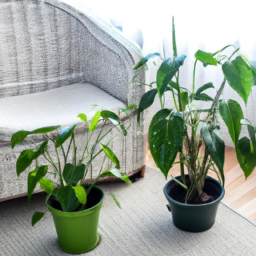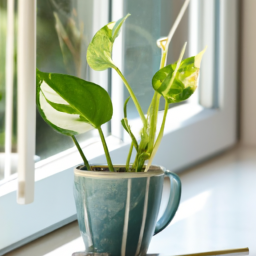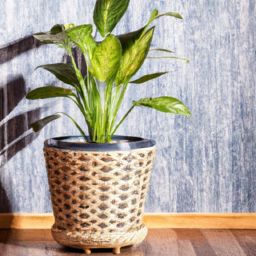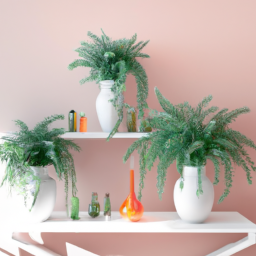
Are indoor plants better than air purifiers when it comes to improving air quality in your home? This age-old debate has sparked curiosity among plant lovers and health enthusiasts alike. Many people believe that indoor plants can effectively filter out toxins and pollutants, while others swear by the efficiency of air purifiers. In this blog post, we will delve into the science behind both options and explore which one might be the best choice for creating a healthier indoor environment.
Benefits of Indoor Plants for Air Quality
Introduction
When it comes to improving air quality in your home, many people turn to indoor plants as a natural solution. But are indoor plants really better than air purifiers? In this article, we will explore the benefits of indoor plants for air quality and compare them to air purifiers to help you make an informed decision.
Natural Air Purifiers
Indoor plants have long been known for their ability to purify the air by removing harmful toxins and pollutants. Plants absorb carbon dioxide and release oxygen through the process of photosynthesis, which helps improve air quality in your home. In addition, plants can also remove volatile organic compounds (VOCs) such as benzene, formaldehyde, and trichloroethylene from the air, which are commonly found in household products and can have negative effects on your health.
Furthermore, indoor plants can help increase humidity levels in your home, which can be beneficial for those suffering from respiratory issues or dry skin. By releasing water vapor through a process called transpiration, plants can help create a more comfortable and healthy indoor environment.
In addition to their air purifying abilities, indoor plants can also improve mental health and overall well-being. Studies have shown that being around plants can reduce stress, anxiety, and fatigue, and improve mood and productivity. This is known as biophilia, the innate human desire to connect with nature, and incorporating plants into your home can help create a sense of calm and tranquility.
Overall, indoor plants offer a natural and aesthetically pleasing way to improve air quality in your home while also providing numerous health benefits.
Comparing Indoor Plants to Air Purifiers
While indoor plants have many benefits for air quality, air purifiers are also a popular option for improving indoor air quality. Air purifiers are electronic devices that work by filtering out pollutants and allergens from the air, such as dust, pollen, pet dander, and mold spores. They can be particularly effective for those with allergies or respiratory conditions, as they can help reduce symptoms and improve overall respiratory health.
One advantage of air purifiers is that they can filter out a wider range of pollutants than indoor plants, including smaller particles that plants may not be able to remove. Air purifiers can also be more efficient at removing pollutants in a shorter amount of time, making them a good option for those looking for quick and effective results.
However, air purifiers can be expensive to purchase and maintain, and they require electricity to operate, which can increase your energy costs. In contrast, indoor plants are a more cost-effective and sustainable option for improving air quality in your home, as they require minimal maintenance and can thrive in natural light.
Ultimately, the decision between indoor plants and air purifiers will depend on your specific needs and preferences. If you are looking for a natural and low-maintenance way to improve air quality and enhance your overall well-being, indoor plants may be the best choice for you. However, if you have specific respiratory issues or allergies that require a more targeted approach, an air purifier may be a better option.
In conclusion, both indoor plants and air purifiers have their own unique benefits for improving air quality in your home. By considering your individual needs and priorities, you can choose the option that best suits your lifestyle and budget. Whether you opt for the natural beauty of indoor plants or the advanced technology of an air purifier, taking steps to improve air quality in your home is a wise investment in your health and well-being.

Comparison of Indoor Plants and Air Purifiers for Improving Indoor Air
Introduction
When it comes to improving indoor air quality, many people turn to either indoor plants or air purifiers. Both options have their own set of benefits and drawbacks, but which one is truly better for your home? In this article, we will compare indoor plants and air purifiers in terms of their effectiveness, cost, maintenance, and overall impact on indoor air quality.
Effectiveness
Indoor plants are known for their ability to naturally filter the air by absorbing toxins and releasing oxygen. Some of the best air-purifying plants include the snake plant, spider plant, and peace lily. While plants can certainly help improve air quality, they may not be as effective as air purifiers when it comes to removing specific pollutants like dust, pet dander, and mold spores.
Air purifiers, on the other hand, are designed to capture and remove airborne particles using filters or ionization technology. High-efficiency particulate air (HEPA) filters are considered the gold standard for air purifiers, as they can trap particles as small as 0.3 microns. This makes air purifiers more effective at removing allergens and pollutants that plants may not be able to address.
In terms of effectiveness, air purifiers are generally more reliable at improving indoor air quality, especially for those with allergies or respiratory issues. However, incorporating indoor plants alongside an air purifier can provide additional benefits and create a more natural and aesthetically pleasing environment.
Cost
When it comes to cost, indoor plants are typically more affordable upfront compared to air purifiers. You can purchase a variety of air-purifying plants for under $20 each, and they require minimal maintenance aside from watering and occasional pruning. However, if you have a large space or want to cover multiple rooms, the cost of buying multiple plants can add up over time.
Air purifiers, on the other hand, can range in price from $100 to $1000 or more, depending on the size, features, and brand. In addition to the initial cost, air purifiers also require regular filter replacements, which can be an ongoing expense. While air purifiers may have a higher upfront cost, they are often more effective at removing pollutants and allergens from the air, making them a worthwhile investment for those with specific health concerns.
In terms of cost-effectiveness, indoor plants may be a more budget-friendly option for those looking to improve air quality in a small space or on a limited budget. However, if you are willing to invest in a high-quality air purifier, it may provide more comprehensive and long-term benefits for your indoor air quality.
Maintenance
Indoor plants require regular maintenance to thrive and continue purifying the air. This includes watering, proper sunlight exposure, and occasional repotting or pruning. Some plants may also be toxic to pets or children, so it’s important to choose non-toxic varieties if you have pets or young family members.
Air purifiers, on the other hand, require minimal maintenance aside from regularly changing the filters and cleaning the unit as needed. HEPA filters typically need to be replaced every 6-12 months, depending on usage and air quality. Some air purifiers also come with additional features like air quality sensors, programmable timers, and automatic shut-off functions for convenience.
In terms of maintenance, air purifiers are generally more low-maintenance compared to indoor plants, which require more attention and care to ensure they continue to thrive and purify the air effectively. If you have a busy schedule or lack a green thumb, an air purifier may be a more practical option for improving indoor air quality without the hassle of plant care.
In conclusion, both indoor plants and air purifiers have their own set of benefits and drawbacks when it comes to improving indoor air quality. Indoor plants can provide a natural and aesthetic touch to your home while helping to filter the air, but they may not be as effective at removing specific pollutants as air purifiers. Air purifiers, on the other hand, are designed to capture and remove airborne particles using advanced filtration technology, making them more reliable at improving indoor air quality for those with allergies or respiratory issues.
Ultimately, the best choice for your home will depend on your specific needs, budget, and lifestyle. Consider incorporating a combination of indoor plants and an air purifier for optimal air quality and a healthy indoor environment. Whether you choose plants, purifiers, or both, taking steps to improve indoor air quality can have a positive impact on your health and well-being.

Factors to Consider When Choosing Between Indoor Plants and Air Purifiers
Cost
When it comes to cost, indoor plants are generally more budget-friendly than air purifiers. While air purifiers can range from $100 to $1000 or more, indoor plants can be purchased for as little as $10 to $50. Additionally, indoor plants require minimal maintenance and can last for years if properly cared for, whereas air purifiers require regular filter replacements which can add up over time. So, if you’re looking for a cost-effective option, indoor plants may be the way to go.
In terms of long-term costs, indoor plants can also provide additional benefits such as improving air quality, reducing stress, and boosting productivity. On the other hand, air purifiers may only provide one specific function – purifying the air. So, if you’re looking for a holistic solution that offers multiple benefits, indoor plants may be the better choice.
Overall, when considering cost, it’s important to weigh the initial investment, maintenance costs, and long-term benefits of both indoor plants and air purifiers to determine which option is more cost-effective for you.
Effectiveness
When it comes to effectiveness, both indoor plants and air purifiers have their pros and cons. Indoor plants are natural air purifiers that can help remove toxins and pollutants from the air through a process called phytoremediation. They can also increase humidity levels and produce oxygen, creating a healthier indoor environment.
On the other hand, air purifiers are specifically designed to filter out pollutants such as dust, pollen, pet dander, and mold spores. They can be more effective at removing these particles from the air compared to indoor plants. Additionally, air purifiers can be more efficient at circulating clean air throughout a room, especially in larger spaces.
When deciding between indoor plants and air purifiers, it’s important to consider your specific needs and concerns. If you suffer from allergies or respiratory issues, an air purifier may be more effective at providing relief. However, if you’re looking to improve overall air quality and create a more natural and inviting indoor space, indoor plants may be the better option for you.
Aesthetic Appeal
One of the benefits of indoor plants is their aesthetic appeal. Indoor plants can add a touch of nature to any indoor space, creating a calming and visually pleasing environment. They come in a variety of shapes, sizes, and colors, allowing you to choose plants that complement your decor and personal style.
On the other hand, air purifiers are typically designed for function rather than aesthetics. They come in a limited range of colors and styles, and may not blend seamlessly with your existing decor. Additionally, air purifiers can take up valuable floor space and may not be as visually appealing as a lush green plant.
When considering aesthetic appeal, it’s important to think about the overall look and feel of your indoor space. If you value a natural and organic aesthetic, indoor plants may be the perfect addition to your home. However, if you prefer a more minimalist or modern look, an air purifier may be a better fit for your decor.
In conclusion, when choosing between indoor plants and air purifiers, it’s important to consider factors such as cost, effectiveness, and aesthetic appeal. Both options have their own unique benefits, so it ultimately comes down to your personal preferences and priorities. Whether you decide to fill your home with leafy greens or invest in a high-tech air purifier, creating a healthy and harmonious indoor environment is key to your overall well-being.
Let’s wrap up what we learned
Many people are turning to indoor plants as a natural way to improve air quality in their homes. While air purifiers are effective at removing pollutants from the air, some argue that indoor plants offer additional benefits beyond just filtering out toxins. Plants not only help to clean the air by absorbing carbon dioxide and releasing oxygen, but they also release moisture into the air, which can help to improve humidity levels and reduce dryness in indoor environments.
Indoor plants have also been shown to have psychological benefits, such as reducing stress and improving mood. In addition, plants can help to reduce noise levels in a room by absorbing sound waves. While air purifiers may be more effective at removing specific pollutants from the air, indoor plants offer a more holistic approach to improving air quality and creating a healthier indoor environment. Ultimately, the decision between using indoor plants or air purifiers may come down to personal preference and lifestyle factors.
Here are some FAQs you’d be interested in:
Q1: Are indoor plants more effective at purifying the air than air purifiers?
A1: It depends on the specific air quality concerns you have. While indoor plants can help improve air quality by absorbing toxins and releasing oxygen, air purifiers are specifically designed to filter out pollutants and allergens from the air.
Q2: Do indoor plants require maintenance to purify the air?
A2: Yes, indoor plants do require regular maintenance to effectively purify the air. This includes watering, pruning, and ensuring they receive adequate sunlight. Air purifiers, on the other hand, require minimal maintenance.
Q3: Can indoor plants remove specific pollutants from the air?
A3: Indoor plants can help remove certain pollutants such as formaldehyde, benzene, and trichloroethylene from the air. However, air purifiers are more effective at capturing a wider range of pollutants, including dust, pollen, and pet dander.
Q4: Are indoor plants a more natural way to improve air quality compared to air purifiers?
A4: Yes, indoor plants are a natural way to improve air quality as they use photosynthesis to absorb carbon dioxide and release oxygen. Air purifiers, on the other hand, use filters and technology to remove pollutants from the air.
Q5: Can indoor plants and air purifiers be used together to improve air quality?
A5: Yes, indoor plants and air purifiers can be used together to improve air quality. The plants can help to add oxygen and remove certain pollutants, while air purifiers can effectively filter out a wider range of pollutants for a more comprehensive air purification solution.
Dr. Olivia Green is a botanist with over two decades of experience in indoor plant cultivation. She holds a Ph.D. in Plant Biology and has dedicated her career to researching plant behavior in controlled environments. Dr. Green is passionate about helping plant enthusiasts master the art of indoor gardening through her extensive knowledge and practical insights.


